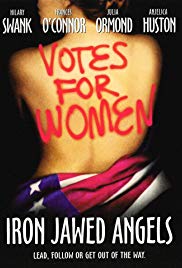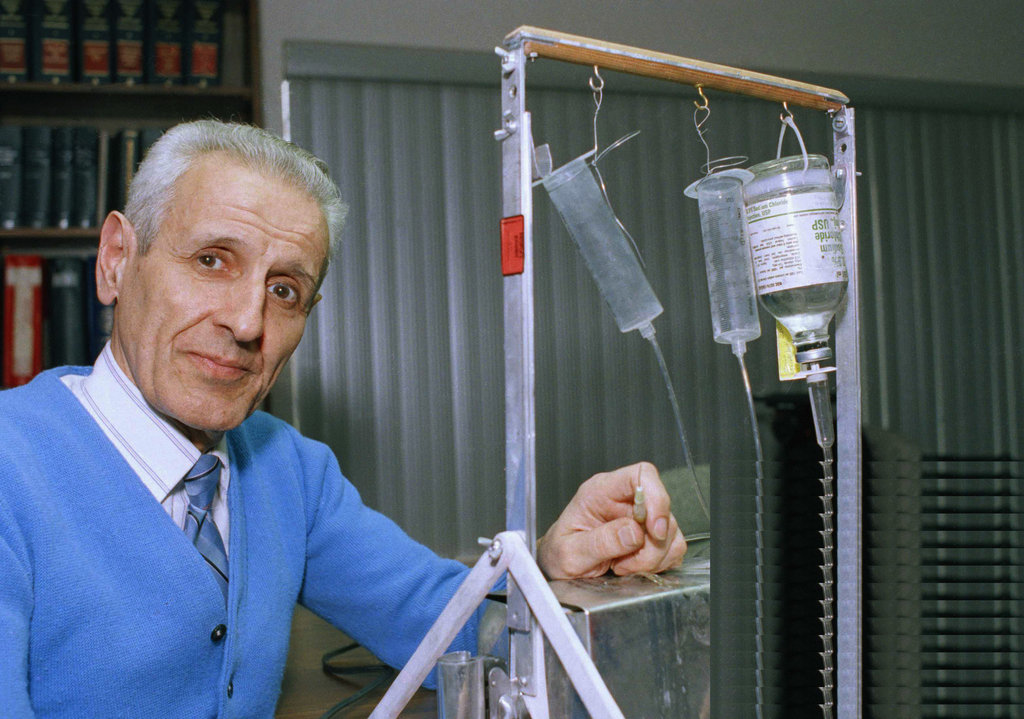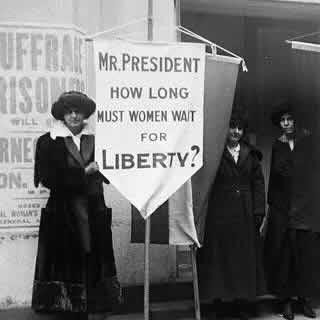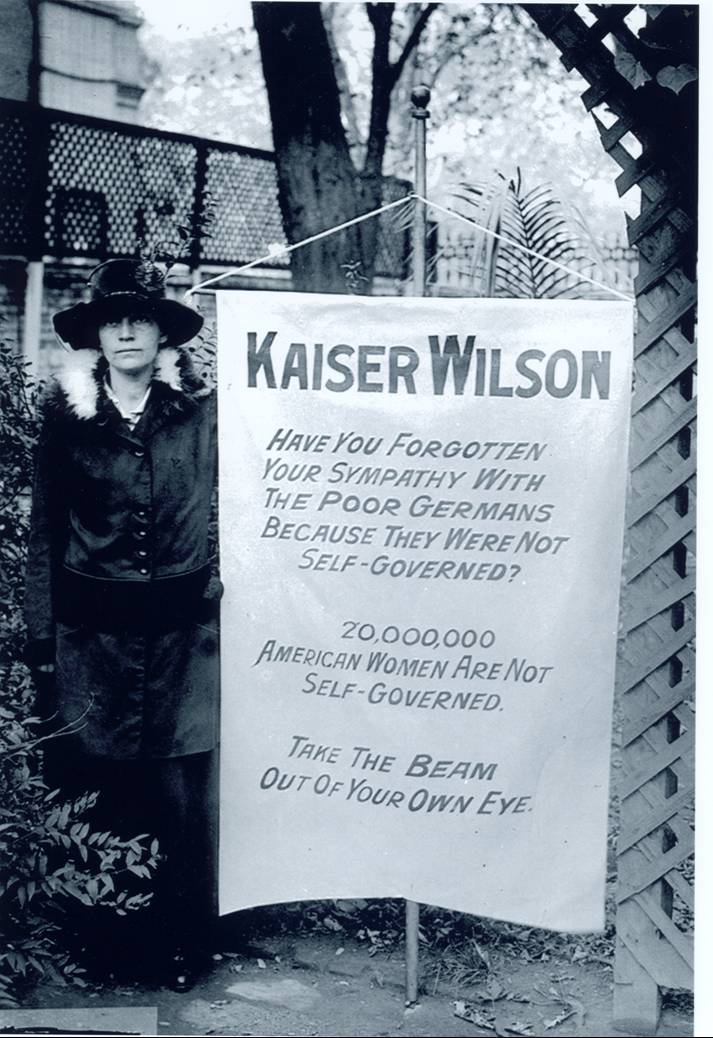1. Why did American society resist women’s suffrage so strongly for so many decades?
Suggested Response:
The resistance to women’s suffrage was based on ingrained sexist beliefs held by both men and women. These beliefs were supported by a host of secular and religious customs and institutions. Certain industries which felt that women would vote for policies inimical to their financial interests funded the opposition to suffrage campaigns. These included the liquor industry which feared, with a certain amount of foresight, that if women got the vote, laws would be passed prohibiting the sale of liquor. Other industries anticipated that reform measures supported by women would increase their costs, for example, by placing restrictions on child labor.
2. Were the militant suffragists led by Alice Paul traitors to their country by continuing their protests after the nation went to war? Should they have put their efforts at suffrage on hold during the war emergency as a matter of patriotism?
Suggested Response:
There is no one correct answer to this question. Any reasoned and well-supported response is appropriate. Strong responses will include the following: Civil and political rights are not suspended just because there is a war. The suffragists had the right to freedom of speech and “peaceably to assemble, and to petition the government for a redress of grievances.” They were certainly not traitors in the technical sense of the word. On the other hand, many will say that during wartime, the people of a country should put aside their differences and work together for victory; and there is a lot of truth in that for most things and, in fact, many suffragists disagreed with Alice Paul’s militants. However, the suffragists led by Alice Paul felt that the right to vote was a fundamental right because women in America were subject to the laws of the country but they were prohibited from voting for the state and federal legislators who made those laws or for the governors or presidents who administered those laws. In addition, this was the second time that suffragists had been asked to suspend their movement because of a war. Back in the 1860s, during the Civil War, other progressives had asked the suffragists to put aside their controversial demands and help in the effort to rid the country of slavery. Their allies, the other progressives, promised to focus on women’s suffrage once slavery had been abolished and black men enfranchised. However, in 1917, more than 50 years had passed since the Civil War had been won, and women still could not vote in about 3/4s of the states. Alice Paul knew that it would be controversial to picket the White House during wartime, but controversy has its advantages for a nonviolent movement. It was a good way to garner media attention which is the major way for peaceful protesters to spread their message.
3. Alice Paul is given a lot of credit for organizing a nonviolent campaign to change American politics and society. However, it could be argued that she had no choice. Miss Paul would have lost the support of American women if she had asked them to turn violent in support of suffrage. Does this argument take anything away from the importance of Miss Paul’s commitment to nonviolence? Explain your reasons.
Suggested Response:
The point of the response is that all nonviolent movements are undertaken by a group without power to change or to overthrow those who are in power. Governments with armies and police have much more power than groups of citizens. The many nonviolent movements of the 20th century that have changed societies and governments demonstrate that the most effective way for powerless groups to secure change is nonviolent mass action. See Learning Guide to “A Force More Powerful“.
4. What was the importance of nonviolence in the NWP’s campaign for a federal suffrage amendment?
Suggested Response:
Instead of news stories featuring rebellious women throwing punches at men or torching buildings (which would have sorely hindered the campaign), the headlines featured women who were respectable mothers, daughters, and wives being physically attacked and subjected to harsh conditions in prison. Alice Paul knew that by appearing peaceful and calm in the face of violence while retaining their commitment to their cause, the suffragists would gain new respect and that their arguments would be taken more seriously.
5. Where did Alice Paul find the philosophical inspiration for her nonviolent philosophy?
Suggested Response:
Her Quaker upbringing was a huge factor in her philosophy. She also read the works of Thoreau and Tolstoy. In addition, Gandhi was practicing nonviolence at the same time and was pointing out the difference between his nonviolent tactics and the violence used by the British suffragettes. Gandhi’s philosophy and tactics may have come to Alice Paul’s attention but historians have found no support for this claim.
6. Where does the phrase, “Take the beam out of your own eye” that was used in the “Kaiser Wilson” poster come from? What did the poster mean by telling President Wilson to “Take the beam out of your own eye”?
Suggested Response:
The expression comes from the King James translation of the Bible, Matthew 7:5. “Thou hypocrite, first cast out the beam out of thine own eye; and then shalt thou see clearly to cast out the mote out of thy brother’s eye.” A “beam” is a large piece of wood and a “mote” is a speck of dust or wood. The suffragists were calling the President a hypocrite for championing the cause of democracy abroad but not extending it to women in the U.S. By extension, they were pointing out the hypocrisy of the entire nation.
7. People call politicians names all the time and politicians and their supporters just take it in stride. Why did equating President Wilson to the German Kaiser in the “Kaiser Wilson” poster enrage the President and the crowds that assaulted the suffragists?
Suggested Response:
It was because there was a large amount of truth in the claim that the President and, by extension, the country, was being hypocritical by going to war to “make the world safe for democracy” while not extending democracy to 20 million American women. In addition, the German Kaiser was the hated enemy leader who was seeking to stamp out democracy in Europe.
8. Are there any existing social injustices that some people believe merit protests, such as picketing, demonstrating, and boycotting merchants?
Suggested Response:
There are many. Here are a few: abortion and restrictions on abortion; the mistreatment of prisoners at Guantanamo; the torture and killing of animals in factory farms and in laboratories; gay marriage and prohibitions on gay marriage; capital punishment; and development on wetlands that destroys animal habitat.
9. A political prisoner is someone who is incarcerated not for criminal activity, but because of his or her political beliefs or activities. The concept was developed in Europe in the 1800s to protect opponents of despotic regimes in Europe. Political prisoners, being different from common criminals, were supposed to be housed in better conditions than existed in most jails. The Wilson administration carefully considered giving the suffragists political prisoner status but ultimately decided that to do so would cause a revolution in American law. Why can’t American law tolerate the concept of political prisoners?
Suggested Response:
Under the U.S. Constitution, no one can be imprisoned unless they have been convicted of committed a crime. It violates the Constitution for public officials to jail someone because of his or her beliefs or political activities unless the person has violated at law. Moreover, the First Amendment protects freedom of speech, thought, and association; it protects the right of the people to peaceably assemble and petition for a redress of their grievances. The concept of a political prisoner, someone who is a danger to the government and whose only offenses are political beliefs or activities, is unheard of in American law. No court would endorse such a classification. Public officials who cause someone to be arrested and imprisoned on the basis of that person’s political views can be sued for violation of that person’s civil rights.
10. Assume that you and people of your sex, nationality, or economic status were not permitted to vote. Would you be willing to go to jail and suffer harsh conditions like those encountered by the suffragists in order to gain the right to vote?
Suggested Response:
A good discussion of this question involves two parts. The first is whether the right to vote is important and worth a substantial sacrifice. The answer to this question in any democracy must be in the affirmative. The right to vote is a basic value of any free people. The disenfranchisement of large groups of people skews the results of elections. The will of the whole people cannot be expressed when some have no power at the ballot box. The second part is whether such a great sacrifice as putting your life in danger, encountering harsh prison conditions, and giving up your liberty for weeks and months at a time is too much of a sacrifice for the right to vote. There is no one correct answer to this question. Each person must decide this for him or herself. There are contributions that people can make for a cause that do not involve risking personal liberty or safety. They can give money, work in a campaign office, lobby, etc. Alice Paul encouraged women to walk the picket line and to risk arrest. She encouraged them to do this when the prospect of arrest and a 30-day or 60-day prison term in extremely harsh conditions was very likely. However, she recognized that it was a great sacrifice and never insisted that anyone get arrested. There were plenty of other jobs for people in the suffrage movement. The women who courted arrest were always volunteers who undertook the risk because of the strength of their commitment to suffrage and their belief that arrest would further the cause.
11. The mistreatment of Alice Paul and her suffragists is not the only time that violence has marred the history of the U.S. The dual tragedies of lynchings and race riots attests to this and, of course, there is the Civil War, the bloodiest war in U.S. history. Further evidence is the violence perpetrated on people trying to change society, such as activists in the Civil Rights Movement, see e.g., “Ghosts of Mississippi“, and workers trying to organize labor unions, see e.g., “Matewan.” in addition, Farmers displaced by the dust bowl of the 1930s who moved by the thousands to California looking for work were assaulted and beaten in communities that felt threatened by their presence. “The Grapes of Wrath” tells this story. Race riots and police brutality still occur. Do you think current-day America is as violent a country as it once was?
Suggested Response:
Arguments can be made both ways. On the one hand, it appears that the United States has moved well beyond its violent past but some problems remain, such as some unjustified police shootings of black men. In addition, there are isolated incidents of violent hate crimes, and of torture in the “War on Terror” but they are just that, isolated, and the persons responsible are often brought to justice. Thus, the basic trend is toward less violence. On the other hand, it could be argued that the torture of prisoners, secret rendition of suspected terrorists, and the Guantanamo prison camp are evidence of a violent culture. The argument would continue that violence is still ingrained in American life and that when times get hard, violent repression will again raise its ugly head again.








